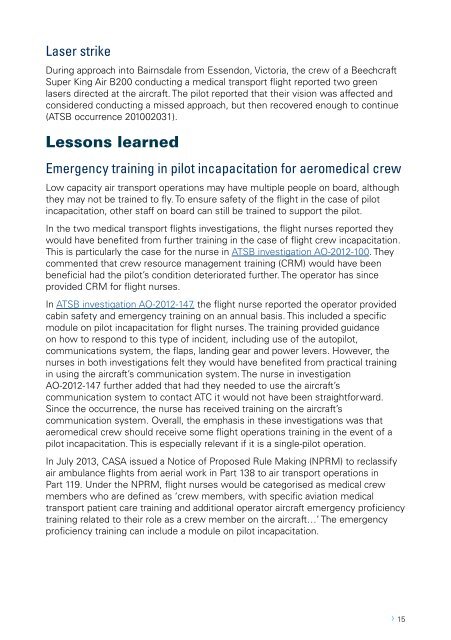Pilot incapacitation occurrences 2010–2014
8rKXy6YKY
8rKXy6YKY
Create successful ePaper yourself
Turn your PDF publications into a flip-book with our unique Google optimized e-Paper software.
Laser strike<br />
During approach into Bairnsdale from Essendon, Victoria, the crew of a Beechcraft<br />
Super King Air B200 conducting a medical transport flight reported two green<br />
lasers directed at the aircraft. The pilot reported that their vision was affected and<br />
considered conducting a missed approach, but then recovered enough to continue<br />
(ATSB occurrence 201002031).<br />
Lessons learned<br />
Emergency training in pilot <strong>incapacitation</strong> for aeromedical crew<br />
Low capacity air transport operations may have multiple people on board, although<br />
they may not be trained to fly. To ensure safety of the flight in the case of pilot<br />
<strong>incapacitation</strong>, other staff on board can still be trained to support the pilot.<br />
In the two medical transport flights investigations, the flight nurses reported they<br />
would have benefited from further training in the case of flight crew <strong>incapacitation</strong>.<br />
This is particularly the case for the nurse in ATSB investigation AO-2012-100. They<br />
commented that crew resource management training (CRM) would have been<br />
beneficial had the pilot’s condition deteriorated further. The operator has since<br />
provided CRM for flight nurses.<br />
In ATSB investigation AO-2012-147, the flight nurse reported the operator provided<br />
cabin safety and emergency training on an annual basis. This included a specific<br />
module on pilot <strong>incapacitation</strong> for flight nurses. The training provided guidance<br />
on how to respond to this type of incident, including use of the autopilot,<br />
communications system, the flaps, landing gear and power levers. However, the<br />
nurses in both investigations felt they would have benefited from practical training<br />
in using the aircraft’s communication system. The nurse in investigation<br />
AO-2012-147 further added that had they needed to use the aircraft’s<br />
communication system to contact ATC it would not have been straightforward.<br />
Since the occurrence, the nurse has received training on the aircraft’s<br />
communication system. Overall, the emphasis in these investigations was that<br />
aeromedical crew should receive some flight operations training in the event of a<br />
pilot <strong>incapacitation</strong>. This is especially relevant if it is a single-pilot operation.<br />
In July 2013, CASA issued a Notice of Proposed Rule Making (NPRM) to reclassify<br />
air ambulance flights from aerial work in Part 138 to air transport operations in<br />
Part 119. Under the NPRM, flight nurses would be categorised as medical crew<br />
members who are defined as ‘crew members, with specific aviation medical<br />
transport patient care training and additional operator aircraft emergency proficiency<br />
training related to their role as a crew member on the aircraft…’ The emergency<br />
proficiency training can include a module on pilot <strong>incapacitation</strong>.<br />
› 15


